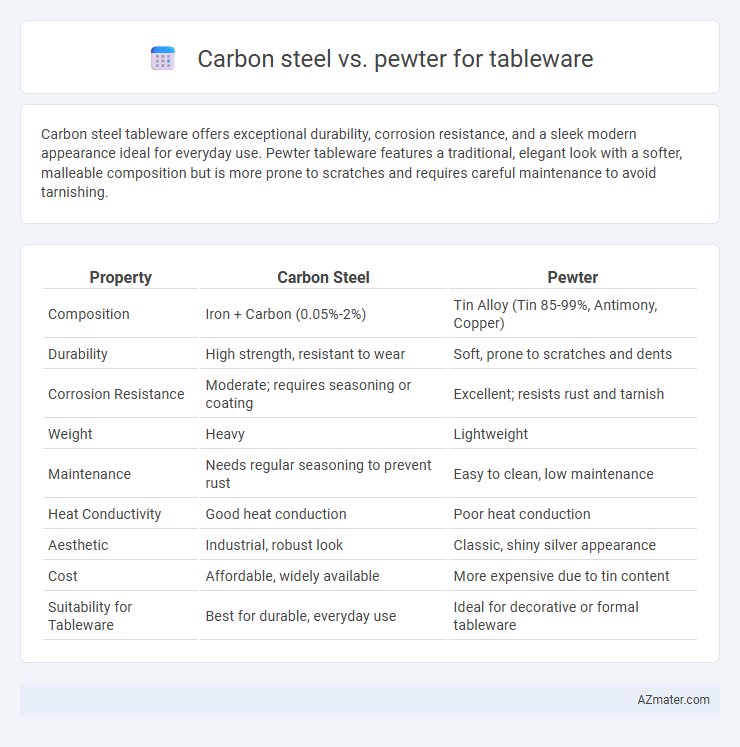Carbon steel tableware offers exceptional durability, corrosion resistance, and a sleek modern appearance ideal for everyday use. Pewter tableware features a traditional, elegant look with a softer, malleable composition but is more prone to scratches and requires careful maintenance to avoid tarnishing.
Table of Comparison
| Property | Carbon Steel | Pewter |
|---|---|---|
| Composition | Iron + Carbon (0.05%-2%) | Tin Alloy (Tin 85-99%, Antimony, Copper) |
| Durability | High strength, resistant to wear | Soft, prone to scratches and dents |
| Corrosion Resistance | Moderate; requires seasoning or coating | Excellent; resists rust and tarnish |
| Weight | Heavy | Lightweight |
| Maintenance | Needs regular seasoning to prevent rust | Easy to clean, low maintenance |
| Heat Conductivity | Good heat conduction | Poor heat conduction |
| Aesthetic | Industrial, robust look | Classic, shiny silver appearance |
| Cost | Affordable, widely available | More expensive due to tin content |
| Suitability for Tableware | Best for durable, everyday use | Ideal for decorative or formal tableware |
Introduction to Carbon Steel and Pewter Tableware
Carbon steel tableware offers exceptional durability and heat retention, making it ideal for cookware and utensils used in both professional and home kitchens. Pewter tableware, composed primarily of tin mixed with small amounts of copper, antimony, or bismuth, provides a classic, elegant appearance with its soft metallic luster and is often favored for decorative or ceremonial purposes. Both materials exhibit unique physical properties: carbon steel is prized for its strength and responsiveness to seasoning, while pewter stands out for its malleability and resistance to corrosion.
Composition and Material Properties
Carbon steel tableware, composed primarily of iron with a small percentage of carbon, offers high durability, excellent strength, and resistance to deformation, making it ideal for long-lasting utensils. Pewter, an alloy mainly consisting of tin with small amounts of copper, antimony, and sometimes lead, is softer and more malleable, providing a smooth, decorative finish but lower structural strength compared to carbon steel. The corrosion resistance of pewter surpasses that of carbon steel, which may require coatings to prevent rust, influencing maintenance and longevity in tableware applications.
Historical Use in Tableware
Carbon steel has been historically prized for its durability and ability to hold a sharp edge, making it a material of choice for knives and utensils in tableware since the Middle Ages. Pewter, an alloy primarily composed of tin, was widely used from the Roman era through the 18th century due to its malleability and affordability, becoming popular for plates, cups, and serving dishes. The transition from pewter to other metals in tableware coincided with advancements in metallurgy and changing aesthetic preferences, while carbon steel remained favored in cutlery for its functional performance.
Durability and Longevity
Carbon steel tableware offers exceptional durability due to its high tensile strength and resistance to deformation, making it ideal for everyday use and prolonged handling. Pewter, composed mainly of tin with small amounts of other metals, is softer and more prone to scratches and dents, limiting its longevity compared to carbon steel. The maintenance of carbon steel involves protection against rust, whereas pewter requires careful handling to avoid tarnishing and physical wear.
Appearance and Aesthetic Appeal
Carbon steel tableware features a sleek, industrial look with a matte or brushed finish that darkens over time, adding a rustic charm and unique character to each piece. Pewter offers a soft, silvery-gray sheen with a subtle luster that exudes vintage elegance and complements traditional or antique-inspired settings. The choice between carbon steel and pewter depends on whether a modern, rugged aesthetic or a classic, refined appearance is desired.
Safety and Food Compatibility
Carbon steel tableware offers excellent durability and heat retention but requires seasoning to prevent rust and avoid potential metal leaching, making it safe for most foods when properly maintained. Pewter, composed primarily of tin with small amounts of copper or antimony, is food-safe if it is lead-free; traditional pewter containing lead poses health risks due to lead leaching. Choosing lead-free pewter ensures non-toxicity and inertness with acidic foods, while carbon steel remains ideal for non-acidic foods when well-seasoned and dried thoroughly after use.
Maintenance and Care Requirements
Carbon steel tableware requires regular seasoning and thorough drying to prevent rust and maintain its non-stick surface, especially after each use. Pewter tableware demands gentle handwashing with mild soap, avoiding abrasive materials to prevent scratching and tarnish, while polishing may be needed periodically to retain its luster. Proper storage of carbon steel in dry environments and pewter in tarnish-resistant conditions ensures longevity and preserves their functional and aesthetic qualities.
Cost and Accessibility
Carbon steel tableware offers a cost-effective option with high durability and widespread availability, making it accessible for everyday use and commercial settings. Pewter tableware, while generally more expensive due to its alloy composition and artisanal craftsmanship, appeals to niche markets and collectors seeking decorative or vintage pieces. Accessibility of pewter is limited compared to carbon steel, often requiring specialized retailers or custom orders.
Environmental Impact and Sustainability
Carbon steel tableware offers durability and recyclability, with a lower carbon footprint compared to plastics, but requires energy-intensive production and maintenance to prevent rust. Pewter, composed primarily of tin with small amounts of copper and antimony, is non-toxic and recyclable, yet mining and refining metals contribute to environmental degradation. Both materials support sustainability through reuse, yet carbon steel's longevity and ease of recycling generally result in a lesser total environmental impact.
Conclusion: Choosing Between Carbon Steel and Pewter
Carbon steel offers unparalleled durability and heat resistance, making it ideal for everyday tableware that requires longevity and sturdiness. Pewter, valued for its elegant, antique appearance and malleability, suits decorative or formal dining settings but demands more care to avoid dents and tarnishing. Selecting between carbon steel and pewter hinges on prioritizing either robust functionality or aesthetic appeal in tableware.

Infographic: Carbon steel vs Pewter for Tableware
 azmater.com
azmater.com